PosiTector 6000
PA2 Instruction Guide
with PosiTector SmartLink

This instruction guide provides support for the PosiTector 6000's SSPC-PA2 feature when used with the PosiTector SmartLink.
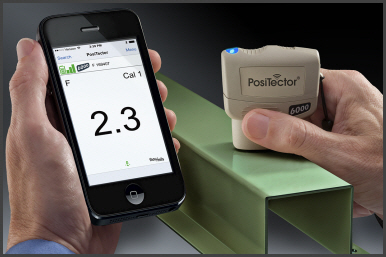
The PosiTector SmartLink and free mobile app allow you to wirelessly connect a wide selection of PosiTector probes to your smart device. Take full advantage of your device's keyboard, microphone, camera, internet data connection, etc. to simplify and enhance your measurement inspection process.
How to use the PosiTector 6000's PA2 mode
Step 1 - Begin a PA2 analysis
Select the Memory option from the gage menu as shown.
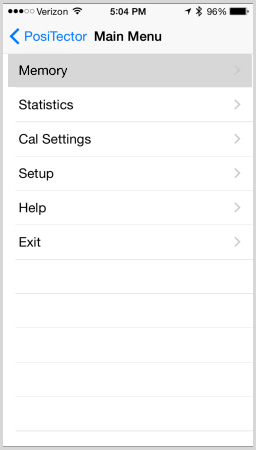
Next, select the New PA2 option from the Memory menu
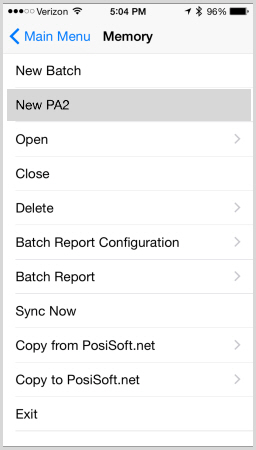
Step 2 - Adjust PA2 parameters as necessary
Review the 6 parameters.
To adjust, touch the appropriate parameter, then use the keyboard to enter desired value. Alternatively, measure a coating with a thickness close to the required value and make final adjustments
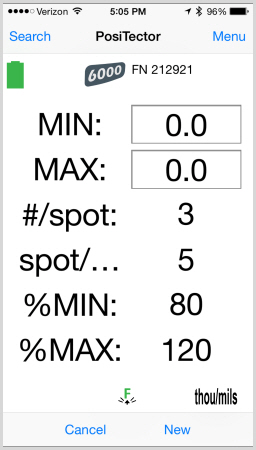
The 6 adjustable parameters are...
MIN: the specified minimum thickness value for the coating system. If only one target thickness is specified, set the MIN to that value. To adjust, touch the MIN parameter, then use the keyboard to enter desired value. Alternatively, measure a coating with a thickness close to the required value and make final adjustments
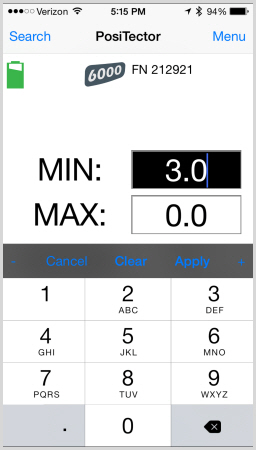
MAX: the specified maximum thickness value for the structure. This value should be that thickness above which adverse performance characteristics appear, such as mudcracking, embrittlement, solvent retention, loss of adhesion, cohesive splitting, etc.
If a maximum thickness value is not specified, set the MAX value to 1,000. To adjust, touch the MAX parameter, then use the keyboard to enter desired value. Alternatively, measure a coating with a thickness close to the required value and make final adjustments
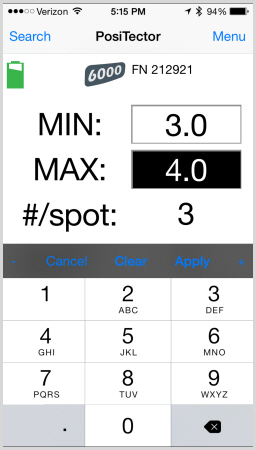
#/spot: the minimum number of individual gage readings required per spot to obtain a spot measurement. PA2 suggests a minimum of 3 readings be taken within a 4 cm (1.5 inch) diameter circle. To adjust, touch the #/spot parameter, then use the keyboard to enter desired value.

spot/batch: the minimum number of spot measurements (sub-batches) required per area (batch). PA2 suggests 5 spot measurements be obtained. To adjust, touch the spot/batch parameter, then use the keyboard to enter desired value.
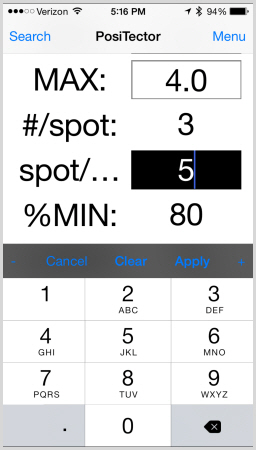
In any measurement there is a certain level of uncertainty. Two people using the same gage will not necessarily record the exact same number for a given spot measurement using the same 4cm (1.5inch) diameter circle. To allow for this natural fluctuation, an individual spot measurement is permitted to be below the specified minimum thickness as long as other spots in the batch area are high enough to make the average thickness meet or exceed the specified minimum thickness. Similar reasoning applies to maximum thickness.
%MIN and %MAX
Table 1 of PA2 provides five thickness restrictions levels.
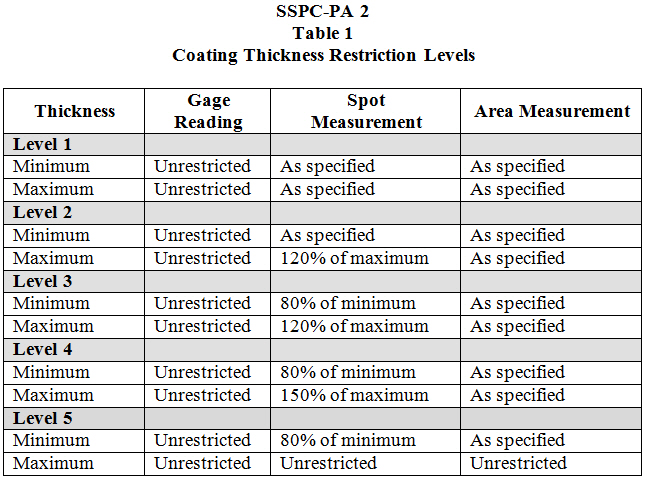
PosiTector SmartLink configuration for each PA2 level:
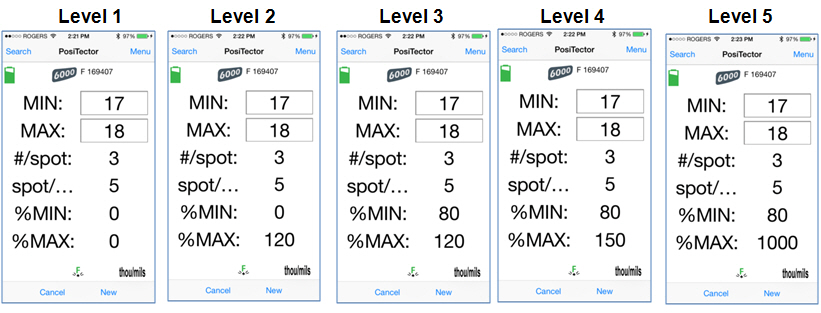
% MIN: Most common is that no single spot measurement be less than 80% of the specified MIN thickness. The PosiTector 6000 allows this value to be changed if desired. To adjust, touch the % MIN parameter, then use the keyboard to enter desired value. To set "As Specified" according to PA2, set this value to 0.
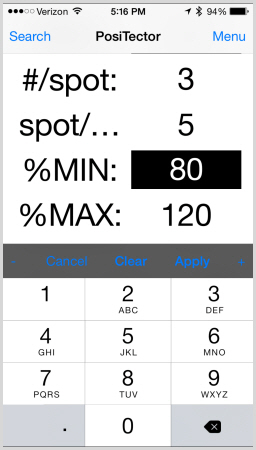
% MAX: Table 1 specifies that no single spot measurement be more than 120% of the specified MAX thickness. The PosiTector 6000 allows this value to be changed if desired. If the MAX value above has been set to 0, this % calculation is made to the MIN value. To adjust, touch the % MAX parameter, then use the keyboard to enter desired value. To set "As Specified" according to PA2, set this value to 0. To set as "Unrestricted"; set the value to 1000.
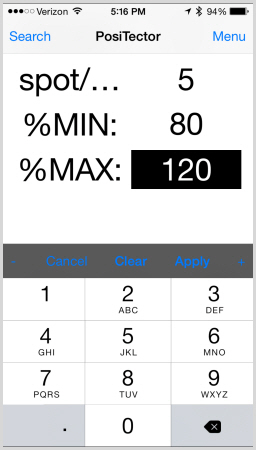
To discard these changes and return to the measurement screen, select Cancel. To accept these values and begin a new PA2 analysis, select NEW.

If a PA2 analysis was already begun before entering this setup, selecting NEW will close/save the existing PA2 batch and begin a new one with a batch name containing the next higher number.
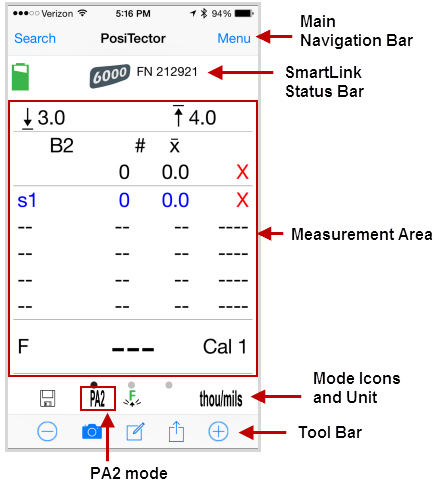
Step 3 - Take measurements
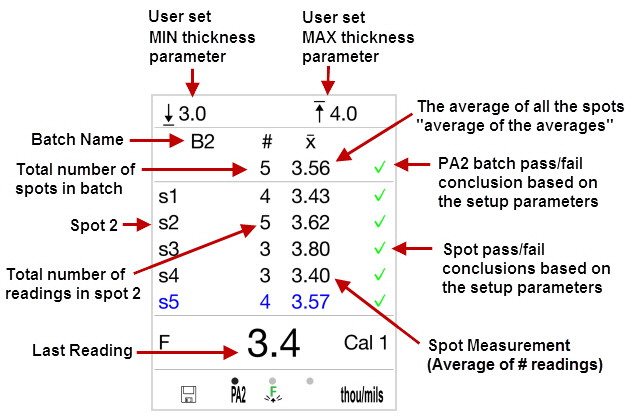
Begin taking measurements in the first Spot. With each reading the following occurs...
1. The reading value is displayed in large numerals at the bottom of the display.
2. The Spot information is updated
- the total number of individual readings taken in the current spot so far
- the average of all readings in the spot. This is the PA2 spot measurement value.
- a Pass  or Fail
or Fail  determination is made for the Spot based on the user-specified parameters
determination is made for the Spot based on the user-specified parameters
3. The Batch information is updated
- the total number of Spots in the Batch (Area)
- the average of the spot measurements (i.e. the "average of the averages").
- a Pass  or Fail
or Fail  determination is made for the Batch (Area).
determination is made for the Batch (Area).
4. If all PA2 criteria from Step 2 have been met, the pass symbol  will appear in the row above the spots.
will appear in the row above the spots.
5. For more detail swipe your finger horizontally across the screen to switch between views.

Step 4 - Change the current Spot or Batch location
To move onto the next Spot press ![]() or the LED button on the PosiTector SmartLink.
or the LED button on the PosiTector SmartLink.
To move onto the next Batch location (begin a new PA2 analysis) select New PA2 from the Memory menu.
There are 3 ways to report results...
Share a PDF report, Export measurement data as comma delimited text files (ideal for importing into a spreadsheet or database application) or Synchronize with PosiSoft.net.
1. Share a PDF Report
Professional PDF reports can be instantly generated and shared via email, Dropbox, AirDrop, AirPrint, Evernote and other apps on your smart device.
To share, press the share icon ![]() and select Report. The Batch Report will generate and display. Sample Report
and select Report. The Batch Report will generate and display. Sample Report
Press ![]() within the Batch Report for share options.
within the Batch Report for share options.
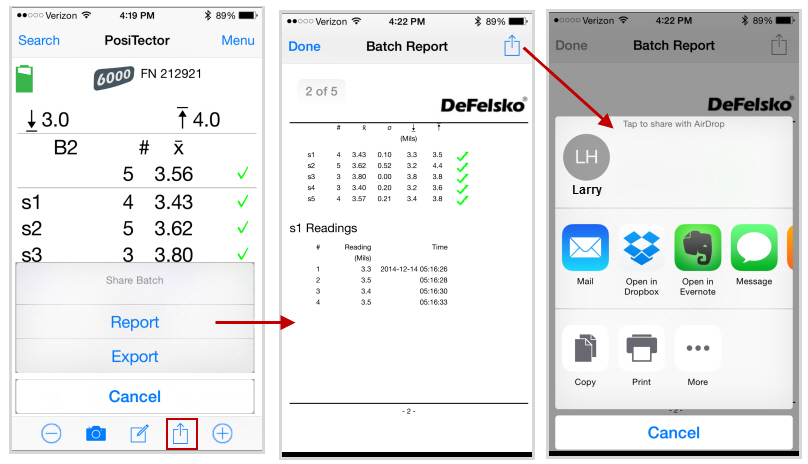
More more information on report generation and customization see: Batch Report Configuration
2. Export data as comma delimited text files
Press the share icon ![]() to export the data files. An email will open containing the files. Enter an email address and press Send.
to export the data files. An email will open containing the files. Enter an email address and press Send.

3. Synchronize measurements with PosiSoft.net.
Synchronizing (Sync) is a two-way communication process between the PosiTector App and PosiSoft.net (no registration required). WiFi/cellular internet data connection required.
Select Sync Now from the Memory Menu. All batches, readings, photos, notes and batch names for all probes will be synchronized.
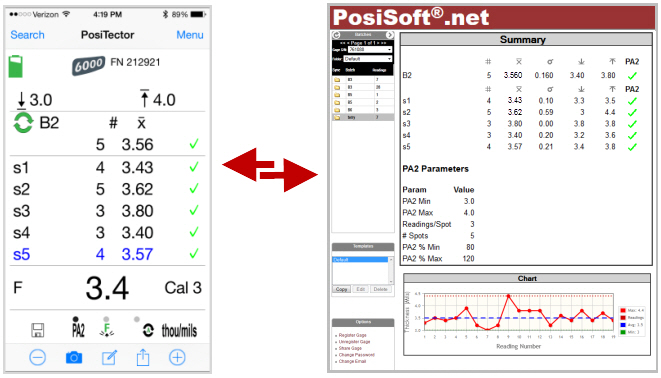
More more information on synchronizing and PosiSoft.net see: Synchronize with PosiSoft.net


SSPC was founded in 1950 as the Steel Structures Painting Council, a non-profit professional society concerned with the use of coatings to protect industrial steel structures. In 1997, the name of the association was changed to The Society for Protective Coatings to better reflect the changing nature of coatings technology and the ever-expanding types of construction materials.
SSPC is the only non-profit association that is focused on the protection and preservation of concrete, steel and other industrial and marine structures and surfaces through the use of high-performance industrial coatings. SSPC is the leading source of information on surface preparation, coating selection, coating application, environmental regulations, and health and safety issues that affect the protective coatings industry.
SSPC standards, guides, specifications, and other technical documents are developed in accordance with voluntary consensus procedures established by SSPC Technical Committees. They are intended to represent a balance of interests, and are believed to represent good current practice. All documents are monitored and revised as practices improve.


The SSPC organization has developed a series of Paint Application Standards, Guides and Specifications. One of them is entitled, "SSPC-PA 2, Measurement of Dry Coating Thickness With Magnetic Gages". It is among the most widely used SSPC standards. (click here to purchase the document).
PA2 describes the procedures to measure the thickness of a dry film of a nonmagnetic coating applied on a magnetic substrate using commercially available magnetic gages. However the described methodology can be used by most non-destructive coating thickness gages including those using eddy-current or ultrasonic principles.
The standard defines a procedure to determine if the film thickness over an extended area conforms to the minimum and the maximum levels specified. This procedure may be modified when measuring dry film thickness on overcoated surfaces.

Contents
Definitions
Description of Gages
Calibration, Verification, Adjustment, and Measurement Procedures
Required number of Measurements for conformance to a thickness specification
Notes on gage principles and various factors affecting thickness measurement
Substrate Roughness, Tacky Films, Curvature, etc.
Variations in Thickness
PA2 was originally developed to analyze large, flat surfaces. But concerns about other shapes and sizes prompted the creation of appendices.
Gage Reading: A single instrument reading at one point.
Spot Measurement: (sub-batch) The average of at least three gage readings made within a 4 cm (1.5 inch) diameter circle.
Area Measurement: (batch) The average of five spot measurements over each 10 m2 (100 ft2) of coated surface, or portion thereof. i.e. the "average of the averages".
Calibration: The controlled and documented process of measuring traceable calibration standards and verifying that the results are within the stated accuracy of the gage. Calibrations are typically performed by the gage manufacturer, their authorized agent or an accredited laboratory in a controlled environment using a documented process. Click here to see a full set of measuring definitions.
TYPE 1 Gage: A magnetic pull-off gage such as the PosiTest FM.
TYPE 2 Gage: An electronic gage that uses electronic circuitry, such as the PosiTector 6000.

There are several ways to evaluate film thickness with the PosiTector 6000 ...
1. Take a single reading.
2. Calculate the average of several readings -- the PosiTector 6000's Statistics mode.
3. Analyze a larger area using a statistical approach -- the PosiTector 6000's PA2 mode.
A large surface usually cannot be characterized accurately by a single reading. Variations in substrate preparation, painting technique, measuring technique, etc. require an analysis of several readings taken over a large portion of the surface.
The PosiTector 6000's statistics mode displays individual readings AND maintains a running average value. It also displays minimum and maximum values.
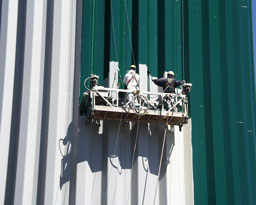
The SSPC organization has taken this a step further by developing a specification for structural steel painters. Known as PA2 this specification has become widely used both inside and outside the structural steel painting industry.
PA2 helps determine if film thickness over an extended area conforms to user-specified minimum and maximum levels.
It recommends that a coated surface be sectioned into one or more large test areas. A minimum of 15 individual readings are taken in 5 groups of 3 readings each. Suggestions are made as to the acceptability of individual readings, spot measurements (the average of each group), and the calculated average of the spot measurements. In simple terms, PA2 suggests the average of a series of average values be used to determine if a target thickness has been met.
Repeated gage readings, even at points close together, often differ due to small surface irregularities of the coating and the substrate. Therefore PA2 suggests a minimum of three (3) individual gage readings be taken for each spot measurement of the coating. These readings are to be taken within a 4 cm (1.5 inch) diameter circle.
SSPC-PA2 Example
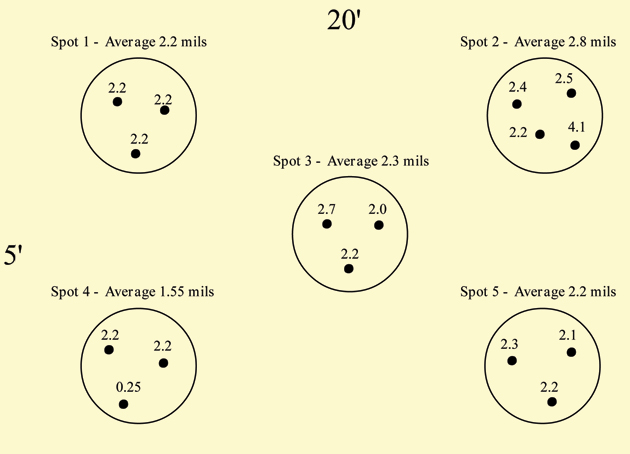
PosiTector SmartLink versions of the PosiTector 6000 have a PA2 mode that helps the user collect measurements in conformance with the PA2 standard. Then, based on user-set parameters that include the target thickness, the gage indicates a pass or fail condition.
Individual readings are grouped into "spots" (sub-batches). A series of spot measurements are grouped into areas or "batches". The film thickness result obtained from each batch, the "average of the averages", is taken to be the representative film thickness over the defined area. The PosiTector App's PA2 mode continually monitors thickness results and reports a pass/fail condition on the current spot and on the batch as a whole.
ASTM D7091 "Standard Practice for Nondestructive Measurement of Dry Film Thickness of Nonmagnetic Coatings Applied to a Ferrous Base and Nonmagnetic, Nonconductive Coatings Applied to Non-Ferrous Metals"
ISO 19840 "Paints and varnishes -- Corrosion protection of steel structures by protective paint systems - Measurement of, and acceptance criteria for, the thickness of dry films on rough surfaces"

Is it possible for all the spots to PASS but the batch to FAIL?
Yes. The pass/fail criteria for a spot is less stringent than for a batch. PA2 allows spot values to under run the target thickness. The batch value cannot.
Is it possible to change PASS/FAIL criteria after all measurements have been taken?
Yes. Select the New PA2 menu option, adjust the individual parameters, then select Apply. All stored PA2 batches will instantly be re-evaluated and a new PASS/FAIL conclusion made.
Can I delete a bad reading?
Yes. Use the ![]() button to delete the last reading taken. Use the View menu option to delete any reading, spot, or batch. Use the Delete menu option to delete spots, batches or the entire contents of memory.
button to delete the last reading taken. Use the View menu option to delete any reading, spot, or batch. Use the Delete menu option to delete spots, batches or the entire contents of memory.
Must I specify both a minimum and a maximum thickness?
With many of the coatings used today it is a good practice to specify both. This range is usually obtained from the coating manufacturer's technical data sheet. But economic factors along with flow characteristics of the coating usually control excessive film build, so it is common to specify only a minimum thickness. When only a single target value is available, set the MIN to that value and set the MAX to 0.


DeFelsko and PosiTector are trademarks of DeFelsko Corporation registered in the U.S. and in other countries. iTunes and AirPrint are trademarks of Apple Inc., registered in U.S. and other countries. Other brand or product names are trademarks or registered trademarks of their respective holders.